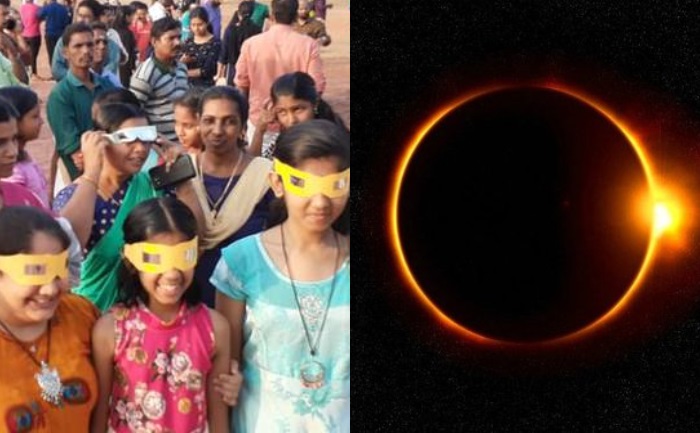In a rare and unusual celestial event, an annular solar eclipse is taking place on 26 December. Yes, the final solar eclipse of the year 2019 has already begun. It will be visible in Karnataka, Kerala and Tamil Nadu before crossing the Bay of Bengal for northern Sri Lanka. The eclipse will also be visible in Saudi Arabia, Qatar, United Arab Emirates, Oman, India, Sri Lanka, Malaysia, Indonesia, Singapore, Northern Mariana Islands, and Guam.
Here is all you need to know about when, where and precautions:
Timing:
In India, the celestial event started roughly around 8:00 am with a partial eclipse. The maximum eclipse will start at 10:47 am when the Moon is closest to the center of the Sun. It will end by 12:30 pm after which the moon will leave the edges of the Sun, ending the partial eclipse by 1:35 pm.
What is an Annular Solar Eclipse:
An annular eclipse happens when the moon does not block the sun completely but looks like a “dark disk on top of a larger sun-colored disk” forming a “ring of fire”. It is one of the most awaited events. Solar eclipses are only visible from within the area where the shadow falls, and the closer you are to the center of the shadow’s path, the bigger the eclipse looks.
A large crowd had assembled at Cheruvathur in north Kerala, the first place in the country where the solar eclipse is visible.
In Kerala, major temples like Guruvayur Sreekrishna temple, Sabarimala Ayyappa temple and Sree Padmanabha Swamy temple are closed for four hours in the morning.
In many parts of western India, especially Mumbai and Pune, people are unable to see the eclipse because of the cloudy skies.
Precautions to be taken during a solar eclipse:
People watching the solar eclipse this morning should use safe viewing equipment and proper techniques to view the celestial event as the infrared and ultraviolet rays of the Sun can cause severe retinal damage.
Seeing the eclipse on an optical instrument through a screen – your mobile phones, televisions or camera screens are perfectly okay. However, looking through binoculars, camera viewfinders, and telescopes, however, can end up causing instant and permanent blindness.
* Do not look at the Sun directly.
* Use solar filters or eclipse glasses to look at the Sun.
* Make sure the glasses meet the ISO 12312-2 standard.
* Do not use homemade filters and ordinary glasses.
* Do not use an unfiltered camera, telescope or binoculars.
Watch solar eclipse Livestream online:
People who cannot watch the last solar eclipse of 2019 directly can see Livestream of the event. There are a couple of websites that will stream the solar eclipse including Slooh.com– the official website of the Sri Lankan astronomy channel called Tharulowa Digital.
This annular eclipse will be the third and final solar eclipse of the year. The next solar eclipse will take place in June 2020 and it will be an annular solar eclipse. It will be followed by a total solar eclipse in December 2020.
Also Read: Total Solar Eclipse 2019: Date, Time, Myths and Places To Observe From

